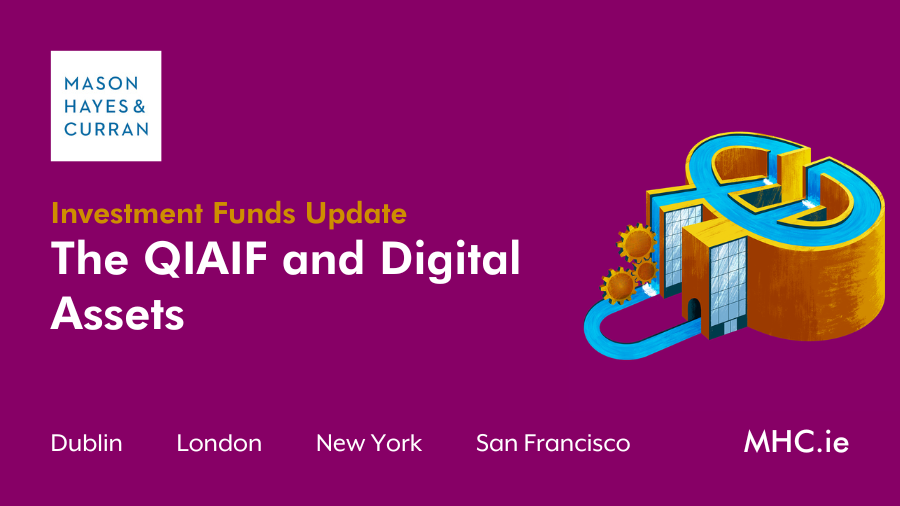
Recent Central Bank guidance has opened the door for to a new type of QIAIF which can invest in digital assets. We review the guidance and the potential implications for the alternative investment funds market.
The Central Bank of Ireland has opened the door to a new type of Qualifying Investor Alternative Investment Fund, or 'QIAIF', which can invest in digital assets. This development has long been speculated on and anticipated by the investment funds industry.
In early April 2023, the Central Bank published the 47th edition of the AIFMD Q&A. The AIFMD Q&A provides a significant update in that the Central Bank has now clarified the ability of Qualified Investor AIFs (QIAIFs) to invest in digital assets, including crypto-assets.
What is considered a digital asset?
The AIFMD Q&A defines a digital asset as an asset that exists in digital form and which can have ownership rights attached to it. The ownership rights depend primarily on cryptography and distributed ledger or similar technology. For the purposes of the AIFMD Q&A, the Central Bank considers digital assets to be ones that are based on intangible or non-traditional underlying assets.
The rise of alternative asset classes has been one of the major investment themes of recent years, as investors diversify their search for yield and asset managers seek to help them achieve their goals. This widened search has been prompted by the poor performance of the more traditional equity and bond asset classes. The traditional asset allocation split in fund portfolios was a 60:40 split, with 60% invested in equities and 40% in bonds. Seeking to improve performance and rebalance portfolios, asset managers are increasingly looking at changing their asset allocation to a 50:30:20 split with 20% invested in alternatives i.e. private assets, infrastructure, private credit and now crypto presents a viable investment option for QIAIFs with the AIFMD Q&A update.
Establishing a QIAIF
A QIAIF is a regulated investment fund vehicle which is authorised and regulated by the Central Bank. The QIAIF enjoys a fast-track regulatory approval process whereby the fund can be authorised by the Central Bank within one business day of filing the appropriate documentation.
However, previously where a QIAIF intended to invest directly or indirectly in crypto-assets, authorisation in one business day was not possible, as the Central Bank required a pre-submission to be made before the application for authorisation could be filed. The AIFMD Q&A has considerably relaxed this requirement as outlined below.
A QIAIF authorised in Ireland benefits from an EU marketing passport, allowing it to market its product to professional investors in any EU Member State, subject to notification to the Member State of the intention to market. There are generally no restrictions on the types of assets in which such a fund can invest and no restrictions on leverage.
Conditions for investment in digital assets
The AIFMD Q&A sets out criteria that a QIAIF must meet in order to be permitted to invest indirectly in digital assets.
Where a QIAIF proposes to invest indirectly in digital assets the following requirements apply:
- The AIFM must have an effective risk management policy to address all risks relevant to investment in digital assets. This must address, at a minimum, risks relating to liquidity, credit, market, custody, operational, exchange, money laundering, legal, reputational, and cyber
- The AIFM must carry out appropriate stress testing on the proposed investment in digital assets. The stress testing should be extreme yet plausible, reflecting asset price volatility of digital assets including the potential entire loss of value in the investment
- The AIFM must have an effective liquidity management policy in place that includes a sufficient suite of tools to enable the AIFM to manage liquidity events arising in the QIAIF
- The prospectus of the QIAIF must contain clear disclosure on the nature of the proposed investment in digital assets and must contain a clear articulation of the risks associated with that investment, and
- The QIAIF should assess the overall construction of its portfolio to ensure that there is an alignment between the redemption profile, the level of investment in digital assets, and the likelihood of illiquidity, both in normal and stressed conditions, in the types of digital assets invested in. In this regard:
- Where a QIAIF proposes to invest up to 20% of its net asset value (NAV) in digital assets, the QIAIF may be structured as having open-ended liquidity, provided that the portfolio as a whole is determined by the AIFM to be suitable for an investment fund providing open-ended liquidity, and
- Where a QIAIF proposes to invest up to 50% of its NAV in digital assets, the QIAIF must have either limited liquidity or be closed-ended.
The Central Bank no longer requires a pre-submission to be made when:
- The QIAIF is open-ended and proposes to invest up to 20% of its NAV indirectly in digital assets, or
- The QIAIF is closed-ended or open-ended with limited liquidity and proposes to invest up to 50% of its NAV indirectly in digital assets.
However, the requirement to undergo a pre-submission process with the Central Bank still applies where the QIAIF either intends to invest directly in digital assets, or where the QIAIF intends to invest indirectly in excess of the respective 20% and 50% limits. The pre-submission must be cleared by the Central Bank before an application for authorisation of the QIAIF may be filed.
The Central Bank has confirmed that direct investment in digital assets will not be permitted until such time as it is demonstrated to the Central Bank that a depositary can meet its obligations under AIFMD to provide custody or safekeeping services to digital assets.
Conclusion
The clarifications brought by the new AIFMD Q&A are a positive development for QIAIFs in the Irish funds industry and could have wider implications across the tech and digital assets industries by opening new investment sources for digital assets.
However, this positive development is restricted to professional investors. Given the specific risks associated with crypto-assets and the Central Bank’s concern that potential retail investors may not be able to appropriately assess the risks of making an investment in a fund which gives such exposures, the Central Bank remains firm on refusing approval for investment in crypto-assets by retail funds and investors.
In the meantime, the Central Bank has confirmed that its approach to investment in digital assets by investment funds will be kept under review. It has also stated that it will continue to be informed by European regulatory discussions on the topic, with further expansion possible as new information or developments emerge.
If you would like to discuss the above or you are considering setting up a QIAIF which invests directly or indirectly in crypto-assets, please contact a member of our Investment Funds team.
The content of this article is provided for information purposes only and does not constitute legal or other advice.
Share this:



